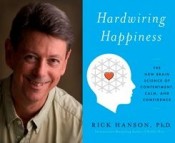Free Forum Q&A: RICK HANSON, author of Hardwiring Happiness
Written on December 31st, 2013 |
Aired: 12/29/13
My guest this week is RICK HANSON, neuropsychologist, and author of the best-seller BUDDHA’S BRAIN. We’re going to talk about his latest book, HARDWIRING HAPPINESS, where he brings together mindfulness and neuroscience and offers pro-active practices to actually shift the brain’s neural structure – the hardwiring – toward calm, contentment, and confidence.
This time of year can be challenging for people. Holidays bring us in contact with family, which for many carries a charge. We’re all asked to be more social than usual. We need a story to tell. And it feels natural to take stock and self assess at the end and beginning of a calendar year. We can be hard on ourselves.
Rick Hanson and I are going to talk about how you can use new lessons science is learning about the brain to overcome it’s — so far evolutionarily successful — negativity bias – the brain’s tendency to hardwire negative and threatening experiences more easily, more quickly than positive ones. It’s important that you avoid predators. And the ones who didn’t had fewer children.
Free Forum Q&A: ALAN WEISMAN, Author of COUNTDOWN Slowing Population Growth Our Last, Best Hope for a Future on Earth
Written on December 10th, 2013 |
Aired: 12/8/13
What do you think are the biggest solvable problems facing humanity? Justice and inequality? Violence and war? Climate change and pollution? Today we’re going to focus on one that I believe underlies all of those: Population.
The last book from today’s guest, ALAN WEISMAN, was thought-provoking, award-winning, and best-selling. THE WORLD WITHOUT US, which was made into a powerful documentary, imagined what would happen to planet earth if humans disappeared. Our massive infrastructure would collapse and vanish without human presence, and nature would swiftly begin to heal without our daily pressures.
But, Weisman, would rather Imagine a successful world with us, and that led to his newest book, COUNTDOWN: OUR LAST, BEST HOPE FOR A FUTURE ON EARTH. For this one, he traveled to 21 countries asking politicians, scientists, family planning specialists, doctors, and religious leaders, crucial questions about how we can successfully deal with the size of human population.
http://littlebrown.com/countdown.html
Free Forum Q&A – RICHARD HEINBERG, Author of SNAKE OIL: Fracking’s Promise of Plenty Imperils Our Future
Written on December 3rd, 2013 |
Aired: 12/1/13
What do you know about hydraulic fracturing or “fracking” of natural gas?Probably depends on who you’re listening to. The fossil fuel industry tells you it’s the biggest energy development of the century, which promises America energy independence for the US and a huge boost to our economy with benefits to local economies. Many of the communities themselves tell a different story – of pollution on the one hand and social disruption on the other.
For the spoils of success, I recommend an article in March 2013 Harpers, Where Broken Hearts Stand, Grief and Recovery on the Badlands of North Dakota by Richard Manning.
RICHARD HEINBERG has a new book, SNAKE OIL: How Fracking’s Promise of Plenty Imperils Our Future, looks at fracking from both economic and environmental perspectives, informed by the most thorough analysis of shale gas and oil drilling data ever undertaken.
Join us as I try to find out, Is fracking the miracle cure-all to our energy ills, or a costly distraction from the necessary work of reducing our fossil fuel dependence?
Free Forum Q&A – JAY HARMON, Author of THE SHARK’S PAINTBRUSH: How Nature is Inspiring Innovation
Written on November 5th, 2013 |
Aired: 11/3/13
Nature, imaginative by necessity, has already solved many of the problems we are grappling with. Animals, plants, and microbes are the consummate engineers. They have found what works, what is appropriate, and most important, what lasts here on Earth.
After 3.8 billion years of R&D on this planet, failures are fossils. What surrounds us in the natural world is what has succeeded and survived. So why not learn as much as
we can from what works?
This week’s guest, JAY HARMON is doing just that, translating nature’s lessons and models into technologies that solve problems and perform tasks more elegantly, efficiently, and economically. He’s the author of THE SHARK’S PAINTBRUSH: Biomimicry and How Nature is Inspiring Innovation. I believe biomimicry – a way of looking and working and designing – has enormous potential to save us from ourselves. I find this one of the most exciting developments in the world at this time.
Free Forum Q&A – TERRY TAMMINEN, frmr Secy Cal EPA CRACKING the CARBON CODE Sustainable Profits in the New Economy
Written on September 4th, 2013 |
Aired 09/02/12
When I first met TERRY TAMMINEN, he was living on a houseboat in the Marina and filling a position he’d founded as the first Santa Monica Baykeeper. No too long before that, he had been running a pool services company. And not too long after, he was Secretary of the California EPA.
Tamminen has reinvented himself successfully in several very different worlds — business, government, non-profit, foundation, from the grassroots to the halls of power. All of this for a long time now to achieve a sound and healthy relationship between society and the environment. He pursues that consistent vision with whatever works.
We’ll talk about the ideas in his book, CRACKING THE CARBON CODE: The Key to Sustainable Profits in the New Economy – which is very much a plan of action for companies who figure out that reducing carbon emissions reduces waste and is therefore good for the bottom line. He’ll tell stories of companies that have made or saved money by cutting carbon.
How has he been able to move things forward through politics and government in an era when so little seems to get done? Bottom line, are we moving fast enough? If not, how do we integrate all these different players to accelerate movement in the right direction?
